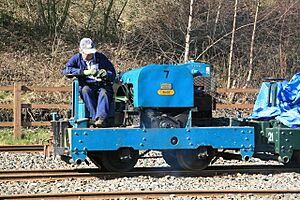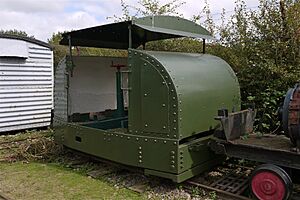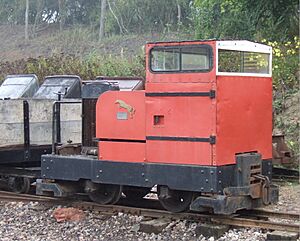Motor Rail facts for kids
Motor Rail was a British company that built special trains called locomotives. They started in Lewes, Sussex, and later moved to Bedford in 1916. The company stopped making new locomotives in 1987. Today, another company called Alan Keef Ltd still provides parts and builds new locomotives using Motor Rail's original designs.
Contents
How Motor Rail Started
The story of Motor Rail began in 1909. A man named John Dixon Abbott invented a special gearbox. This gearbox helped change speeds and reverse direction in vehicles like trams. In March 1911, he created a company called The Motor Rail & Tramcar Co Ltd. His goal was to use his gearbox in trams and railcars.
Around the same time, the company moved to Lewes, Sussex. There, they built a small train for narrow tracks. This train used Dixon-Abbott's special gearbox and an engine made by W.H. Dorman & Co.
Building Locomotives for War
In January 1916, the company helped the War Department. The War Department needed small trains for military supply lines during World War I. These trains had to run on 600 mm (1 ft 11 5⁄8 in) wide tracks. They also needed to be light and strong enough to pull up to 15 tons at about 5 miles per hour.
Motor Rail designed a new locomotive for this purpose. It had a strong frame and two powered axles. A petrol engine and the Dixon-Abbott gearbox were in the middle. The driver sat on one side, able to see and drive in both directions. This design worked very well.
After testing a prototype, the War Department ordered many of these locomotives. Because of these big orders, the company moved to a new, larger factory in Bedford in May 1916.
Armoured Locomotives
The company also made an armoured version of their locomotive. This version was stronger and had a more powerful 40 hp Dorman engine. It came in three types:
- Open: Had armoured plates at the ends and a roof that could be adjusted.
- Protected: Like the Open version, but with armoured side doors and special viewing slots.
- Armoured: Completely covered with armour, including the roof. The driver looked out through narrow slits.
Motor Rail supplied over 900 of these locomotives during World War I. After the war, these strong, affordable trains became popular. They were used in many places where steam engines were too heavy or expensive. This helped Motor Rail find its special place in the market. They continued to build trains with petrol and diesel engines, mostly for narrow gauge railways.
In 1931, the company changed its name to Motor Rail Ltd. They registered the name Simplex in 1953, though they had been using it since 1915. Later, in 1972, the company became Simplex Mechanical Handling Ltd.
Types of Locomotives
Motor Rail built many different types of locomotives over the years. Here are some examples:
| Fuel | Horsepower | Weight | Notes |
|---|---|---|---|
| Petrol | 20 | 2 ton 5 cwt | This was the original "trench tractor" built for the War Department. |
| Petrol | 40 | 6 ton 6 cwt | An upgraded and armoured version of the 20 hp model, built for the Ministry of Munitions. |
| Petrol | 10/20 | 2 ton | This was the first new design after World War I. |
| Diesel | 18 | 4 ton/5 ton | This was their first diesel locomotive. Most were sold to other countries. |
| Diesel | 20/28 | 4 ton/5 ton | Used a Dorman 2RB engine. Later, its power was changed to 20/36 hp in 1932. |
| Petrol | 25/35 | 4 ton | A more powerful, heavy locomotive used by construction companies from 1930-1937. |
| Diesel | 65/85 | 10 ton | Only one of these heavy locomotives was built in 1932. It was not very reliable and was later scrapped. |
| Diesel | 25/35 | 4 ton | This model replaced the 20/36 hp. It used the same frame and gearbox as the Petrol 25/35 hp. |
| Petrol | 25/40 | Only one was built for the Ford Motor Company in 1932. It used a Ford car engine. | |
| Petrol | 25/26 | 2 ton/3 ton | This model replaced the 20 hp from 1934. It was available in two different weights. |
| Diesel | 25/28 | 2 ton/3 ton | This model also replaced the 20 hp from 1934 and was available in two different weights. |
Other Products Motor Rail Made
Besides locomotives, Motor Rail also made other interesting vehicles.
Tramcars
Early on, Motor Rail was involved in making self-propelled tramcars. These were like small trains that ran on city streets. In 1915, a magazine reported on a "Simplex Rail Coach" made in Lewes. It weighed 12 tons and could carry 70 people. It was powered by a 45 hp Dorman petrol engine. The company stopped making tramcars around 1931.
Inspection Cars
In 1919, Motor Rail built special inspection cars for the Ministry of Munitions. These cars were used to check railway lines. They were lightweight, weighing only 3.25 tons, but could carry up to 2 tons of cargo. They were very fast, reaching speeds of 43 miles per hour during tests.
Dump Trucks
In 1939, Motor Rail started making dump trucks, called "Motor Rail Dumpers." These were 4-ton trucks with two-wheel drive that ran on tires, not rails. They also used a Dorman engine and a version of the Dixon-Abbott gearbox. A working example from 1947 can still be seen at the Moseley Railway Trust. These dumpers could carry 3 cubic yards of material and climb steep hills. They were available with the driver's seat at the front or the back.
Preserved Locomotives
Many Motor Rail locomotives are still around today! They are probably the most common type of narrow gauge locomotive found in the United Kingdom.
You can find Motor Rail locomotives at many Heritage railways, including:
- Almond Valley Light Railway
- Amberley Museum Railway
- Battlefield Line Railway
- Chasewater Railway
- Corris Railway
- East Anglian Railway Museum
- East Lancashire Railway
- Ffestiniog Railway
- Golden Valley Light Railway
- Giant's Causeway and Bushmills Railway
- Great Bush Railway
- Great Central Railway
- International Rhine Regulation Railway (Austria)
- Lakeside and Haverthwaite Railway
- Lea Bailey Light Railway
- Leadhills and Wanlockhead Railway
- Leighton Buzzard Light Railway
- Lincolnshire Coast Light Railway
- Meirion Mill Railway
- Moseley Railway Trust
- Old Kiln Light Railway
- Ouche Valley Railway (France)
- Romney, Hythe and Dymchurch Railway
- Volk's Electric Railway
- Wales West Light Railway (USA)
- Welsh Highland Railway
- West Lancashire Light Railway
- Wicksteed Park, Kettering, Northamptonshire
See also
- Lister Rail-Truck, a similar light locomotive, from R A Lister of Dursley





